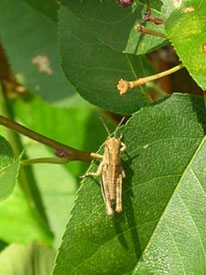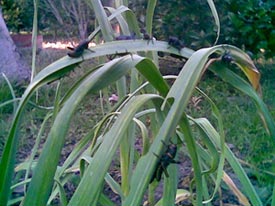
Grasshoppers will snack on most any plant.
Grasshoppers used to remind me of youthful summer days spent wandering through the fields of Spartanburg, South Carolina. Now when I see one, my mind conjures up images of ravaging locusts spreading chaos throughout the land. Of all the garden pests I've dealt with, the grasshopper is the lone insect to make my “Most Wanted” list. Only grasshoppers have the size, population, and appetite to decimate a garden. They are voracious, consuming an estimated 25 percent of the available forage in the western states annually.
One or two grasshoppers in the garden are tolerable. A dozen or so can cause a serious problem. Any more than that feels like a plague. A couple of years ago I let them get out of hand, and they ruined my container gardens. Whatever was not nibbled was splattered with their feces.
No plant is safe. Grasshoppers will eat even purportedly unpalatable aromatic plants like thyme, rosemary, sage, chives, hyssop, nasturtiums, and St.-John's-wort. Even the vaunted wildlife-resistant amaryllis family, which includes daffodils, amaryllis, crinums, clivia, and ismene, is fair game for grasshoppers. The gardener's best friend in the fight is a humid, warm spring that fosters fungal diseases in the newly hatched nymphs that limit their numbers. Barring that, you must take action.
Young grasshoppers have a number of animal and insect enemies. But mature grasshoppers grow to more than 2 inches long and are highly mobile, and the few predators they have (shrews, toads, and kestrels) aren't city dwellers. For centuries farmers have used chickens, ducks, and other poultry as effective controls, but in an urban setting with zoning laws, that's a challenging option.
Many natural products claim repellent effects, but there is no consensus on their efficacy. Neem oil, garlic oil, and pepper spray have shown mixed results. Horehound, cilantro, and calendula are reported to have repellent qualities when grasshopper populations are low. A border of these plants might deter grasshoppers and send them elsewhere to forage, but as I mentioned earlier, they can and will eat anything when they're hungry enough. These plants may or may not protect your garden, but if they do, you'll have the added bonus of ingredients for summer salsas and cough syrup.
Baits containing the protozoan Nosema locustae, sold under brand names such as Semaspore, Nolo Bait, or Grasshopper Attack, are used as biological control agents. The good news: these controls are selective to grasshoppers and won't harm beneficial insects. The bad news: the baits are slow acting and most effective in large fields against the less mobile juveniles.
Once 'hoppers reach adulthood, in an urban garden the only sure remedies are chemical and mechanical. Most garden centers carry pesticides effective against grasshoppers. Read labels carefully and apply as recommended. If you're using a pesticide to protect edibles, be sure it is labeled for use on your crops. Do not harvest within the pesticide's active period (stated on the label), and as always, wash produce before eating.

Lookout, here they come!
If you're an organic gardener or want to preserve beneficial insects, then grasshopper control becomes a hands-on task. Look for the pests while they're small and still developing, when you can easily squish them or vacuum them off plants. Once they reach adulthood, put on your gloves, grab your preferred weapon (trowel, broom, flyswatter, stick, or old tennis racket), and start smashing. This method works only in isolated areas where new grasshoppers cannot easily immigrate as when a garden is next to a field. They are easiest to spot during midday while they're feeding, but they're slower and easier to hit in the morning before they warm up.
A bad infestation may take several campaigns to reduce the population to tolerable levels. Complete eradication is difficult to achieve manually because grasshoppers are shy (as in they hide) and aware (as in they see you coming). In the summer of 2006, I made grasshopper-bashing a daily ritual. Once I got the population to a manageable level, the goal became to eradicate at least five a day. I played this game for several weeks before I gained the upper hand.
There are some benefits to having a few grasshoppers around; live ones make great fishing bait and your angler friends will be happy to take some off your hands. There are also those who consider them a tasty snack, but that's another story.